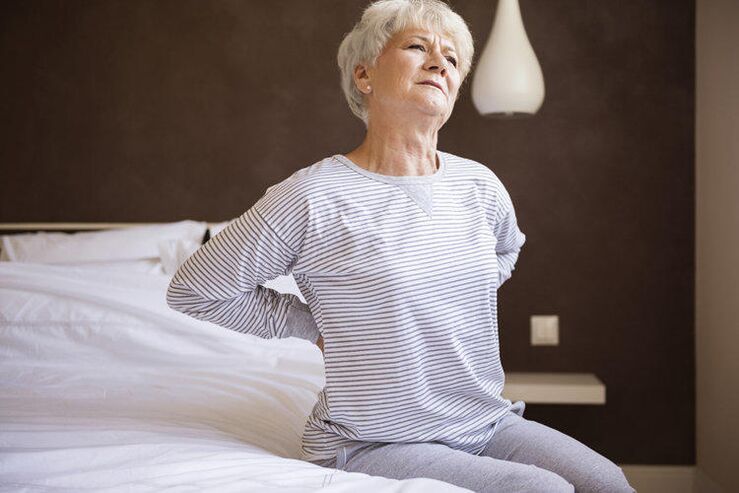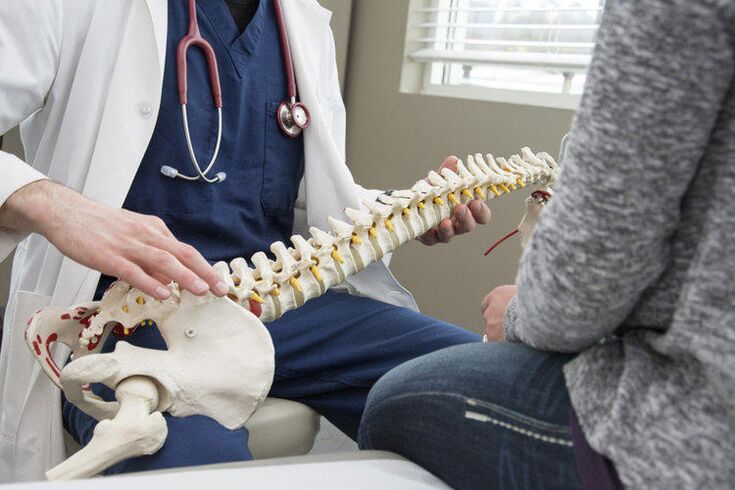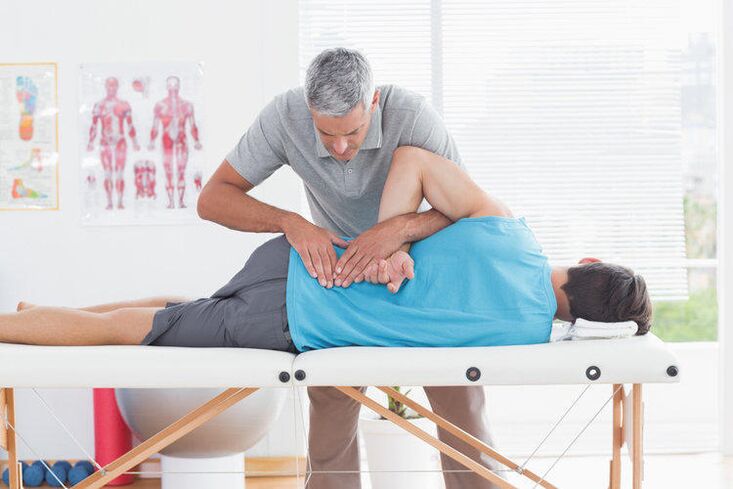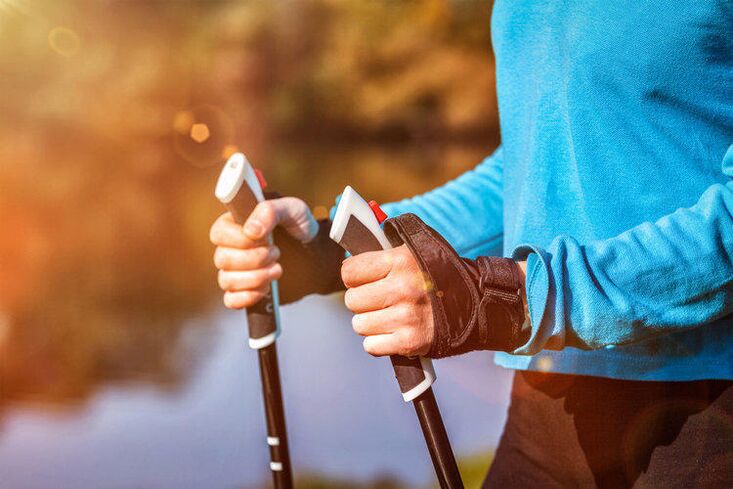Osteochondrosis is a disease in which degenerative distrus changes are diagnosed in the fabrics of the cartilage of the spine, also accompanied by structure disorders and functionality of the intervertebral discs. Depending on the location of the damaged tissues, the osteochondosis of the cervical, thoracic and lumbar are distinguished.

What is osteochondrosis?
Osteocondrosis is a disease of the spinal column in which degenerative and dystrophic lesions of the intervertebral discs occur. With the development of osteocondrosis, the degenerative dyeing lesions apply to the vertebral tissue.
The main feature that indicates the development of osteochdrosis is the pain in the neck, in the lower part, in the lower back, with progression, the pain "gives" in the hands, in the chest, on the shoulders, at the top of the thigh, etc. With negative dynamics of osteochondosis, atrophy of muscle tissue, altered sensitivity, as well as internal dysfunction, provocation, depression, depression, depression, reduction, reduction of their repression, reduction, reduction of their repressed, depression, reduction of their repressed, depression, reducing their repressed, depression, reduction, supply, supplement, supplies. supply, to the depressed. displacement. In the absence of timely therapy, osteochondosis develops to an incurable state.
The causes of osteochondosis
The main factor in the development of osteocondrosis is an irregular load on the spine. The habit of carrying a bag on one shoulder or in one hand, an incorrect installation in a seat position, a dream on an excessively soft mattress, a high pillow, which wears anatomically incorrect types of shoes are a common cause of improper distribution of the load.
Further risk factors include hypodynamia, a sedentary lifestyle, excess weight, back injuries, lower limbs, dishes and other musculoskeletal system disorders, as well as degenerative processes related to age in age -related changes in the blood flow of the spine.
In the etiology of osteocondrosis, the following factors can also play a role:
- Physical overtention of the body;
- neuro-emotional exhaustion;
- Metabolic disorders, poisoning, diseases of the gastrointestinal tract that prevent full assimilation of nutrients;
- Professional risks, in particular, work on vibration platforms;
- genetic predisposition;
- Violations of posture during active growth, scoliosis;
- Wear uncomfortable shoes (narrow, heels);
- prolonged and/or regular dehydration;
- lower diet, hypovitaminosis;
- smoke;
- Pregnancy, in particular more, in combination with an unrelated muscle apparatus (due to the movement of the center of gravity of the body).
Development phase of osteochondosis
Osteochondrosis in the dynamics of the disease passes four phases:

- The osteochondrosis of the 1st stadium (grade) is characterized by the initial phase of the pathology in the Polos nucleus of the intervertebral disc. Due to the excessive load, the process of dehydration (dehydration) of the nucleus begins, which leads to a decrease in the parameter of the height of the disc and the occurrence of cracks in the fibrous ring. The symptoms in this phase are generally absent, a small discomfort can occur with a prolonged living room in a static uncomfortable pose, active movement, etc. ;
- At 2 phases, a decrease in the height of the discs leads to a decrease in the distance between the vertebrae and the relaxation of the vertebrates and ligaments. This causes greater mobility of the vertebrae with affected discs, which is dangerous with their movement or slipping. In the second phase of the disease, discomfort occurs, pain, especially with some types of load, movements, positions;
- The stadiums of the osteocondrosis 3 (grade) are characterized by the formation of prolapse and protrusions of the intervertebral discs, can be accompanied by subluxis and/or by the development of the arthrosis of the intervertebral joints. With some types of movement, patients feel rigidity, insufficient mobility, a tingling feeling, numbness can occur in the limbs. At this stage, osteochondrosis is clearly felt in the back, neck, lumbosacral or coccyx department, depending on the location of the affected discs;
- In 4 phases of the osteocondrosis, the body is trying to regulate the consequences of the hypermability of the vertebrae and adapt to the compromised function of the spinal column. Osteophytes, the new bone formations, which grasp the vertebral fixation are formed in the places of contact of the vertebrae. However, in some cases, osteophytes can cause violation of the nerves, injure the vertebrae. Fibrous ankylosis begins in intervertebral discs and joints. In the absence of microtrauma and infringements of the nerve roots, the symptoms of the disease subside.
Symptoms of osteochondrosis
The main symptoms of osteocondrosis are a feeling of discomfort and/or pain in the neck, back. The severity of the sensations and the presence of further symptoms depend on the stage of the disease. When examining the patient and collects an anamnesis, the specialist leads the initial diagnosis, taking on the presence of osteochondrosis by visually determined curvature of the spine observed in the transversal or longitudinal plane of the spine. The pathologies of the intervertebral discs of the cervical and lumbar are much more often found than the degenerative and dystrophic changes in the sternum area.
The signs of osteochondrosis, warned by the patient, include a periodic or permanent sensation of bull -fatigue, deleted or pronounced, depending on the stage of the disease, the pain. The pain can be located in the neck, back, in the chest, in the shoulder belt, the movements of the upper limbs is complicated.
The clinical picture of osteochondosis depends largely on the location of the pathology, on the degree of development of the process, on the individual characteristics of the patients. The pathology of the intervertebral discs, the movements, the protrusion, the hernias and an increase in osteophytes lead to various consequences. Among the most common, violations of normal blood circulation in the tissues, pinching of nerve endings, dysfunction of the spinal canal, edema, fabric fibrosis and structures are distinguished.
These consequences can be accompanied by many different symptoms, leading to an incorrect diagnosis of diseases.
The most common and characteristic symptoms of osteochondrosis include the following:
- Pain in the back, neck, back, shoulder belt, rib areas;
- discomfort, rigidity of body movements that occur in some positions of the body, inclinations, curves, increase in muscle tension;
- a feeling of numbness of the upper and lower ends;
- Muscle and joint discomfort, muscle cramps;
- headache, dizziness, increase in fatigue;
- pain in the heart;
- violation of the sensitivity of the hands;
- Muscle hypotension.
The symptoms of osteocondrosis differ according to the location of the pathology:
- With osteochondrosis of the cervical column, neck pain, hands, shoulder belt, which radiates in the shoulder area and prevail the shoulder; Headache, dizziness, tremoli of "flies" or spots in front of the eyes, there are noise in the ears;
- With damage to the thoracic spine, the pain is located in the chest area, in the heart, in the internal surface of the shoulder, there are also the area of the armpits, the respiratory discomfort, the lack of breath is possible;
- The osteochondrosis of the lumbosacral column manifests itself from pain in the lower back with radiation to the legs, upper thighs or pelvic organs, sexual dysfunction is often united.
The surface symptoms - back of the back, pain - can indicate not only the presence of osteochondrosis, but also the addition of other diseases or the development of other pathological processes and disorders that are not associated with the dystrophy of the intervertebral discs. The diagnosis of osteochondrosis can only be done by a specialist and the car -mediation with these symptoms is unacceptable.
Diagnosis of osteochondrosis

To make a diagnosis, instrumental exam methods are used:
- X -ray examination of the spinal department;
- myelography;
- Neurological survey of sensitivity, reflections.
Additional methods prescribed for the differentiation and clarification of the diagnosis, the pathology stage includes:
- computerized tomography of the spine (CT);
- nuclear magnetic resonance imaging (Jamr);
- Magnetic resonance imaging (MRI).
Directions for Osteochondosis therapy
The treatment is based on an integrated approach and, depending on the phase, lasts from 1 to 3 months of intensive care and 1 year of support to consolidate the result and the prevention of the impact.
Osteocondrosis is carried out therapy for two directions depending on the degree of osteochondosis and patient health. The conservative treatment of the disease consists in taking drugs, in the execution of a series of exercises. Surgical treatment in almost all situation cannot be the first choice method and is prescribed in the absence of positive dynamics, the progression of the disease against the background of prolonged conservative therapy.
In addition to medical therapy methods, it is necessary to follow the general recommendations for osteochondrosis: to observe a diet, take necessary measures for rehabilitation.
Conservative treatment of osteochondosis
Conservative therapy aims to stop pain syndrome, normalizing the functionality of the spine and the prevention of negative changes
The conservative treatment of osteochondrosis includes the following types of therapy:
- Drug therapy. Medicines for osteochondrosis are used to stop pain syndromes, inflammatory processes in tissues and normalize the metabolic processes of the body. With the pronounced pain syndrome, it is recommended to use the pharmacological blocking of nerve endings, which also contribute to a decrease in the severity of the muscle-syrical syndrome. The following types of blocks are distinguished: block of trigger points, intraosseum, facet, paravertebral, epidural;
- Physiotherapy methods. The physiotherapy procedures help to reduce pain, to increase the effect of medicines, are also used during the rehabilitation period. The most common use of ultrasound waves, magnetic fields, low frequency currents, laser rays, etc.
- Methods of physiotherapy exercises (exercise therapy) and Kinesitherapia. The spice complex with regular and correct execution contributes to the correction of posture, strengthens muscle corset, the binding system, normalizes muscle function, reduces the compression of the nerve fibers and helps the prevention of complications of the osteocondrosis. The methods of exercise therapy and the Kinesatherapeutic procedures aim to normalize metabolic processes, restoring full nutrition of intervertebral discs, restoring the arrangement of the vertebrae and discs between them, uniform distribution of the load in the musculoskeletal system;
- massage. Manual massage techniques are used to improve the flow of blood to the tissues, relieve muscle cramps and terminals and generally improve blood circulation. The hydromass as the direction of therapeutic activity in addition to the effects listed contributes to the normalization of the body's nervous system;
- Manual therapy. Manual therapy methods are selected individually. The point on the body's musculoskeletal system helps to improve blood circulation, the circulation of the sap, improves metabolism, promotes the mobility of the musculoskeletal system, strengthens the immune system and acts as a means to prevent complications of osteochondosis;
- Therapy with the traction method (traction) of the spine using special equipment. The purpose of manipulations is to increase the intervertebral space with normal parameters, correction of violations of the structure of the spinal column.
Prevention of osteochondrosis

The causes of osteochdrosis are mainly connected in the absence of attention to the requirements of the body, malnutrition, excessive loads on the body. To prevent the onset of pathological changes in the spine and limit the dynamics of existing osteochondosis, it is recommended to adhere to the general principles of a healthy lifestyle:
- Exception of the possibility of hypodynamia: moderate sports: charging, running, swimming, bicycle, skiing, gymnastics, types of struggle not contact, etc. ;
- When working or other form of activity linked to a long stay in a static position, it is necessary to take breaks for warm every 45 minutes to restore blood circulation. If necessary, sit for a long time, you should choose the right chairs, the chairs to ensure the support of the spine, monitor compliance with the standards for the position of the hands on the table, the legs on the floor or a special stand, the posture accustomed (even relaxed shoulders, relaxed shoulders);
- For night sleep, it is necessary to select an elastic and best orthopedic mattress with a flat surface, avoid high or too flat cushions;
- If necessary, lift and/or wear heavy objects to avoid idiots, raise gravity from the semi -preacision position, use special belts that support the lower back;
- The choice of orthopedically correct shoes: with the corresponding foot with a width, without high heels and its timely replacement will help reduce the load on the spine, this is particularly important for women during the recovery period of a child. In summer, do not neglect the ability to walk barefoot on an irregular surface, which strengthens the muscles of the foot and relieves tension from the musculoskeletal system;
- The correct diet, the consumption mode contributes to general health and help to normally maintain metabolism;
- With the tendency to increase emotionality, anxiety with the muscle spasmodic reaction to stress, it is worth studying relaxation methods.
















































